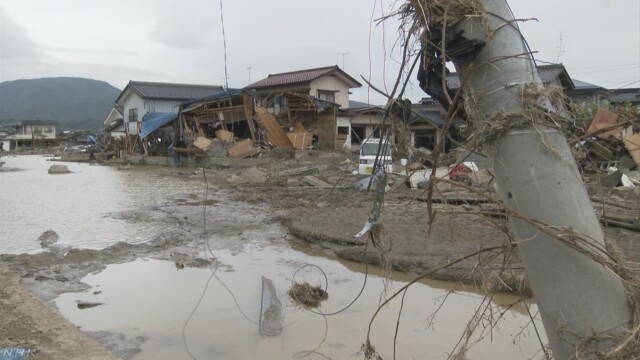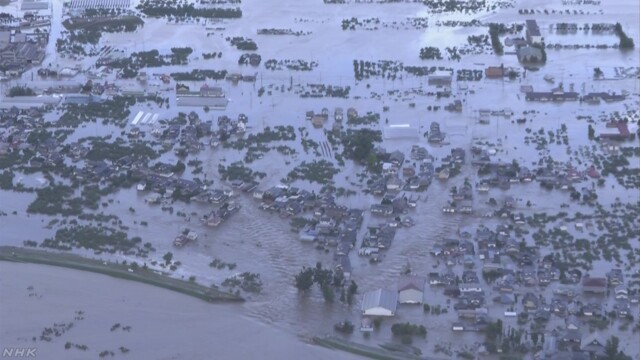Systems of the flood control, infrastractures, and…
Posted on October 19, 2019Last week a super typhoon Hagibis attacked East Japan. This typhoon, which was said as the biggest typhoon in the history of nature, caused serious damages to large areas, such as 79 deaths, 11 missings, about 45,000 houses flooded, 365 landslides, power failers, the suspension of water supply, transportation and distribution. The direct cause of these damages was the flood of rivers. Because of the heavy rain, 71 rivers burst their banks in 128 points and a lot of other rivers flowed over their banks. Why did so many rivers flood?


Left https://www3.nhk.or.jp/news/special/disaster/typhoon19/
Right https://www3.nhk.or.jp/news/html/20191019/k10012139561000.html?utm_int=detail_contents_news-related_002
The flow of water of rivers is usually controlled by the system consisted of various components such as dams, banks, the river itself, reservoirs, retarding basins. These components work to absorb the change in the amount of water and keep it constantly. However, because of the tremendous inflow of water, some rivers, unfortunately, flooded this time. These rivers had each different flood control system and it might have affected each result. For example, the Tama River is the only river that flooded in the Tokyo area. Some areas didn’t have any embankments along this river. Besides, this river had no large reservoirs and retarding basins. As a result, the system of the Tama River was not able to absorb the increase of water and overflowed in the areas where had no embankments. In contrast, the Tsurumi River that flows next to Tama River had a large retarding basin in the city area prepared for the crisis. This time, 940,000,000 liters of water flowed into this basin and it was thought that it had a big effect to protect the city area along the river from the flood. However, the amount of rainfall that we have never imagined flowed into many rivers that were a part of each flood control system. Then some systems weren’t able to absorb the fluctuation (lost their resilience) unlike Tsurumi River and caused the flowing of water into city areas.
How could we prevent this terrible disaster? Should we have built more infrastructures such as embankments or basins to prevent such floods? However, we know that we cannot implement it so easily because there is another layer of the system beyond the flood control systems above. That system consists of the relationship among various stakeholders such as local governments, residents, and government (and the ministry of infrastructure versus the ministry of finance). In the area where the Tama River flooded, the construction of embankments was delayed due to the opposition from the residents because they wanted to keep good scenery. Especially in the constructing of infrastructures, each actor claims each goal and its goal often changes easily over time. (E.g. While the goal of the whole system should be the safety and comfort of residents, the government’s goal sometimes turns into the construction of a dam and using up budgets, and residents’ goal sometimes turns into preventing them.) As a result, people sometimes forget the entire goal.
Also, I would like to mention another system which is the relationship between extreme weather, climate change and global efforts against climate change. Climate change is not the only cause of extreme weather, but a lot of institutes point out the causality between them. In Japan, extreme weather and disasters by it recently happen every year. Not only Japan. Hurricane Sandy attacked New York in 2012. While cold waves damaged Canada and the U.S. this January, people suffer from heatwaves around the world. However, each country claims each goal and it causes the delay of global measures against climate change.
Where are the leverage points to change these systems? Meadows mentioned changing or transcending paradigms as higher leverage points of systems. Although it is very difficult, we can seek to set a harmonized goal together with various stakeholders. However, in this world that is changing dramatically, don’t we need to return to our basic paradigm and think about the problems? Perhaps, it may better to accept every year flood and adjust the life and structure of the city along rivers. Perhaps, we may be able to accept extreme weather and the declining of human beings (Of course, it’s an extreme way!)
How might we design the opportunities, places or movements that various stakeholders can think the paradigm together? We, as designers, have to think about it as our leverage points.
EH
Refelences
Meadows, H. Donella. Thinking in Systems: A Primer. 2008.
CNN News: Typhoon Hagibis death toll rises to 74 as thousands are left stranded in the cold without power, October 16, 2019 https://www.cnn.com/2019/10/15/asia/japan-typhoon-hagibis-aftermath-intl-hnk/index.html
NHK News: Typhoon Hagibis aftermath October 19, 2019 https://www3.nhk.or.jp/nhkworld/en/news/special/01/1919/
And other Japanese sites about typhoon Hagibis